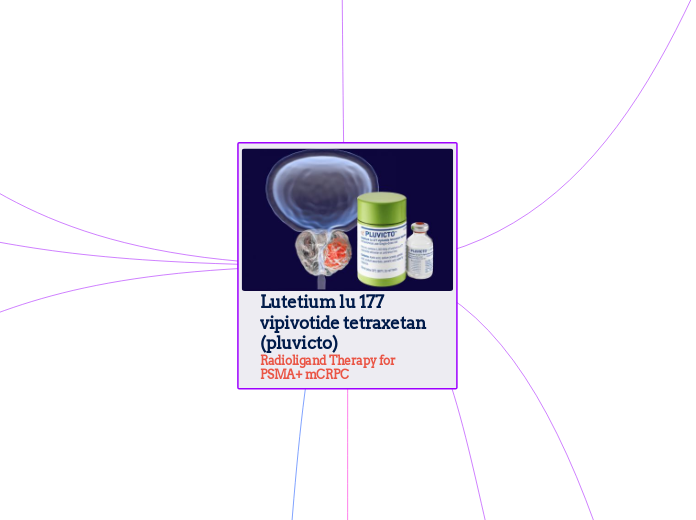によって Eibhlis Myers 2年前.
457
Lutetium lu 177 vipivotide tetraxetan (pluvicto) Radioligand Therapy for PSMA+ mCRPC

によって Eibhlis Myers 2年前.
457

もっと見る
0.9% - ↑ creatinine
3% - Grade 3 or 4 acute kidney injury.
Fatal events (n=5)
2 deaths (0.4%) - intracranial hemorrhage and subdural hematoma in association with thrombocytopenia.
1 death due to sepsis and concurrent neutropenia.
1.1% grade ≥3 pancytopenia occurred (including 2 fatal events)
15% grade 3 /4 ↓ hemoglobin ↓ 9% platelets ↓ 7% leukocytes ↓ 4.5% neutrophils
Significant increase in Overall Response Rate (ORR)
PSA Decline 46% vs VS 7% 46% of patients who received Pluvicto (BSOC) PSA decline ≥ 50% VS 7%B SOC alone
Median Overall Survival 15.3 months-11. 3 months
Radiographic Free Survival 8.7 months- 3.4 months
Best standard of care - as chosen by physician throughout the trial
Following VISION trial
Consult the product batch release certificate to identify the source of stable isotopes used- appropriate management for different types of isotopes
In accordance with local radiation safety federal laws.
Store below 30 do not freeze
120 hours (5 days)
Struggled to produce/ source enough radioactive material to meet demand
Manufacturing halted last May to sort out supply issues- resumed
Complex to make
However
Production limits mean demand is greater than supply
$45,657 for a supply of 1 solution
Novartis bought Pluvicto in its $2.1 billion deal for Endocyte
predicting Pluvicto could eventually earn over $2 billion a year
No therapeutic options remaining
Severe renal toxicity
Embryo-fetal toxicity
Life threatening myleosupression
Infertility
Principles of ALRA (as low as reasonably achievable).
No dose adjustment rec-ommeded - kidney imparimeny- risk of toxicity
Effects of more severe kidney impairment or end stage kidney disease has not been investigated.
Radiation absorbed doses [mean calculated absorbed dose for 6 x 7.4 GBq (44.4 GBq cumulative activity)
The 6-cycle cumulative estimated absorbed dose in the blood-based red marrow was 1.5 Gy.
Maximum penetration of lutetium-177 in tissue is ≈ 2 mm (mean penetration is 0.67mm)
Organs with highest radiation absorbed: Lacriminal glands, salivary glands , large intestine (left colon, rectum, right colon,kidneys, urinary bladder wall).
Administered every 6 weeks for up to 6 treatments.
Administered by a healthcare professional, certified in radio pharmacotherapy.
Blood tests preformed pre and during treatment to monitor PSMA levels.
Do
Targeted RLT offers the possibility to treat prostate cancer lesions in a specific and tumour selective manor by exploiting the cell surface proteins mainly expressed on maligant cells.
PSMA-617 (precursor molecule)
Therapeutic radiation can be delivered via PSMA while minimising radiation related side effects. PSMA -targeted RLT uses a radiolabelled small molecule ligand (PSMA617) that binds with high affinity to PSMA, resulting in internalisation and retention within the targeted PC cell.
PSMA-617 complexed with radionucleotide Lu-177
Intra tumoral half life
60/160 hours
Maximal tissue penetration
2mm
Path length of B particles
medium length B emitter
shorter B length- better irradiation for small tumours
direct energy to tumour than surrounding tissue
Physical 1/2 life
6.64 days
+ high intratumoral retention
reduces dosing frequency
PSMA is a transmembrane glycoprotein involved in various cellular functions, such as cellular uptake of folate, cell migration, and cell survival.
While PSMA is expressed at low levels in normal prostate epithelium, it is overexpressed (up to 1000 times higher) in 90–95% of prostate cancers. In contrast to benign prostatic epithelium where PSMA resides in the cytoplasm, PSMA is in the luminal epithelium of prostatic ducts in prostate cancers and presents a large extracellular binding domain .
PSMA expression is positively correlated with more aggressive disease, including high PSA, high Gleason scores, and early recurrence. The highest levels of PSMA expression are found in metastatic and castrate-resistant disease
Due to its overexpression on the surface of PC cells, PSMA remains a useful protein target for targeted diagnostic processes and radionuclide therapy in PC
>80% of patients with prostate cancer express PSMA
Therapeutic Indications/ eligibility
Androgen deprivation therapy, in adults previously treated with androgen receptor pathway inhibitors and taxes.
Administered with androgen deprivation therapy
Androgen receptor pathway inhibitors
Taxanes
PET scan performed to check PSMA+ for Pluvicto eligibility
Androgen Depletion Therapy is continued
ADT highly effective- elicits a PSA response
10/20% of patients become castration resistant within 5 years
Castration Resistant Prostate Cancer Therapeutics
>50% die within 3 years with historical standard therapies
NCCN,ESMO,APCCC
None have been proven to prolong survival
No proper sequence for delivery
Tax and based chemotherapy
Chemotherapy side effect profile
Limited options failure of chemotherapy
l
5 year survival = 30%
90% of patients with mCRPC develop bone metastasis
Androgen Depletion Therapy (ADT)
Radiological therapy
Surgical